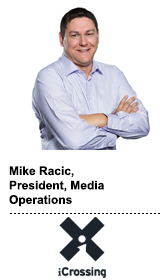 Clients want their agencies to operate in fluid, multidisciplinary teams.
Clients want their agencies to operate in fluid, multidisciplinary teams.
That’s hard to achieve for larger holding companies traditionally siloed into distinct arms. Disparate units working toward internal goals often find themselves competing instead of collaborating to meet client KPIs.
Hearst-owned marketing agency iCrossing is challenging this model with a new structure that promotes omnichannel planning. Originally a search agency, iCrossing began working across channels to offer a full set of marketing services for clients. Now, it’s integrating those services across the agency.
Mike Racic, iCrossing’s president of media operations, recently came aboard to help realize this goal. He joined after working at Universal McCann and then leading agency partnerships at Rocket Fuel.
“ICrossing pulls expertise from across different areas to service an account,” Racic said. “It’s less about training generalists in each area, and more about widening employee skill sets and deepening each team’s understanding of how others think and work.”
He sat down with AdExchanger.
AdExchanger: How is iCrossing’s approach to media unique?
MIKE RACIC: We don’t have a trading desk or believe in the arbitrage model. We are fully transparent. We get paid to drive marketing outcomes that pivot to a business outcome. Why am I talking about CPMs and click-throughs? You know what they are before you start and they won’t change [more than plus or minus 10%]. Clients want to know: Do you understand my business and can you help me drive it?
We’re not owned by a holding company, but a media company that produces a lot of content and has a deep understanding of consumer insights, and that’s a powerful position to be in. And it ties naturally into being channel-neutral.
What does having access to Hearst data and resources allow you to do?
Hearst sits on a wealth of information from their different properties. That’s a treasure trove of first-party data we use for market and consumer trends. What are consumers doing? What devices are they interacting with? What are they wearing? What car do they drive? It’s about forming an opinion about what’s happening in the marketplace to tell our clients what they need to do differently.
How do you structure account teams at iCrossing?
We set up teams that are focused on clients based on our talent. Even if we have an account that’s siloed by channel, we’re gathering total consumer insights. If you’re just a search client of ours, you will have a search team. However, they will be working with an analytics person who derives insights and a strategy person for a deeper understanding of the target.
The unbundling of services is going to come full circle. Everyone’s demanding integrated services. The bigger agency models aren’t set up like that.
A lot of holding companies are attempting to break down silos and create integrated teams for clients. Do you think they’ll be able to achieve that the way you have?
They’ll be able to achieve it on bigger accounts that have scale. But can you systematically do that through an entire holding company or entity within it? That’s debatable.
At iCrossing, everyone gets the same training in programmatic, search, strategy and creative. It doesn’t matter if [an account is] big or small. The services and quality you’ll get are the same. At a bigger holding company that is almost impossible to do.
How are you connecting media outcomes with business outcomes for your clients, and how do you measure that?
It’s a combination of really hard business metrics around sales and share points and softer metrics around brand propensity, brand lift and value proposition. Integrating tech stacks is one of the most valuable things we can do. Every client has their own data infrastructure and everyone is trying to sell them another one. Our job is to figure out how to use what they have to derive insights and drive impact.
Do clients usually come to you with their own tech or do they seek recommendations?
Some clients have a system that they’re happy with. We figure out how to utilize that. How do you extract more value than they’re getting?
We’re not going to say, “This is the one-size-fits-all.” We can hold the contract or they can, but we don’t want to own their data.
We heard that you replaced Red Aril, the data platform you acquired in 2011.
We use Core Audience along with a proprietary DMP to drive data to get new insights, target, etc. But we’re not arbitraging our clients’ data. We’re not sharing it with other clients or running it through any of Hearst’s systems. Clients give us a bunch of data and we send back refined information, but that information is theirs, not ours, to keep.
What’s in your stack?
We have an insights platform with first- and third-party data for every client. We’re using it from a channel allocation perspective and all of that gets fed back to the client to use with every partner they have.
We also have multiple partner relationships, for example Kenshoo. When you combine the power of us and Hearst, there are very few tech partners that we don’t have an existing relationship with.
How does your experience at Rocket Fuel help you at iCrossing?
Seeing the inner workings of an ad tech company and what it values gives me a different view of what’s important. Certain things I did that were second nature at an ad tech company would never happen at an agency. Ad tech companies value ideation and people that have thoughts and the passion to follow through. At an agency we need to reward those people.
Then there’s the little things you take in from working at a tech company. Agencies think that they’re a velocity business, but some of these tech companies are working at two times [the pace] and everyone goes home at 5 p.m. It’s about focusing on the task at hand and cutting out all the ancillary stuff.
How many people are doing media at iCrossing? What do your media and programmatic capabilities look like?
We are around 200 people in the United States and 300 globally. We’re in the middle of a hiring spurt because of client wins.
A lot of people view programmatic as a channel, but it’s not. Programmatic is a way of buying. We have a group of people focused around audiences that will buy using programmatic channels to reach them. We let insights drive what we’re buying programmatically.
What’s special about your approach to talent?
Everyone has a seat at the table when we’re talking about solving client needs. We’re telling someone they have a world of possibilities in front of them versus saying, “You’re a search person” or “You’re doing video.” We’re empowering individuals to do more.
We don’t sit people out of the ideation process.
Edited for clarity and length.














